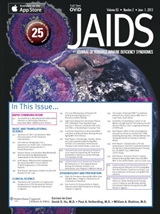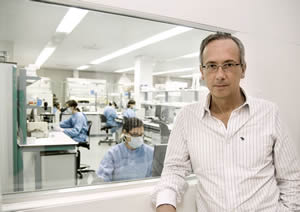IrsiCaixa confirms that treatments against HIV do not completely eliminate the infection and provides guidelines that may improve the therapy for 30% of the patients under treatment
- The Institute for AIDS Research IrsiCaixa, jointly funded by "la Caixa" Foundation and the Catalan Government’s Department of Health, confirms the presence of slight quantity of active viruses that infect new cells in HIV-positive patients who are under seemingly effective treatment.
- The results declared by IrsiCaixa, in parallel to the new data from a prestigious American research group, finalize a long medical controversy showing that a slight HIV replication continues to exist in some patients who have got undetectable level of virus in their blood. These results were first published worldwidely in the journal of Nature Medicine in March 2010 by IrsiCaixa.
- The research, of which findings will be published in the American scientific journal Journal of AIDS JAIDS, was funded by Merck. The study provides reorientation guidelines for the design of new therapeutic strategies that may lead towards the eradication of HIV. It describes how to improve the theraphy for 30% of patients under treatment who has got a detectable level of viral replication in their blood.
- The research also provides evidence to improve clinical trials of eradication combined with a vaccine that are currently being carried out in the framework of the HIVACAT program for HIV vaccine research and developement. HIVACAT is composed of Catalonia’s two longest established and leading AIDS research centres, the Institute for AIDS Research IrsiCaixa and the AIDS and Infectious Diseases Service at Barcelona’s IDIBAPS-Hospital Clínic, in conjunction with the organization ESTEVE, and with the support of “la Caixa” Foundation, the Catalan government’s Department of Health and the Department of Economy and Knowledge plus the Clinic Foundation at Barcelona’s IDIBAPS-Hospital Clínic.
 The Institute for AIDS Research IrsiCaixa, jointly funded by "la Caixa" Foundation and the Catalan Government’s Department of Health, leads a new study that finalizea long medical controversy showing that antiretroviral treatment does not cure HIV infection. The study confirms the presence of slight quantity of active viruses that infect new cells in 30% of HIV-positive patients, who are under seemingly effective treatment, finalizea long medical controversy, after the first results published worldwidely in the journal of Nature Medicine in March 2010, also by IrsiCaixa, and in parallel to the new data from a prestigious American research group. The study was funded by Merck and it has just been published in the June issue of the American scientific journal Journal of AIDS JAIDS.
The Institute for AIDS Research IrsiCaixa, jointly funded by "la Caixa" Foundation and the Catalan Government’s Department of Health, leads a new study that finalizea long medical controversy showing that antiretroviral treatment does not cure HIV infection. The study confirms the presence of slight quantity of active viruses that infect new cells in 30% of HIV-positive patients, who are under seemingly effective treatment, finalizea long medical controversy, after the first results published worldwidely in the journal of Nature Medicine in March 2010, also by IrsiCaixa, and in parallel to the new data from a prestigious American research group. The study was funded by Merck and it has just been published in the June issue of the American scientific journal Journal of AIDS JAIDS.
The discovery has important clinical implications. It could explain why, despite long-term treatment, antiretroviral drugs do not completely cure HIV infection. Besides, the study provides reorientation guidelines for the design of new therapeutic strategies that may lead towards the eradication of HIV. First, the study describes how to optimize the theraphy for 30% of patients under treatment who has got a significant level of viral replication in their blood, by adding a new drug. Secondly, the research proposes how to improve some clinical trials on eradication combined with a vaccine that are currently being carried out in the framework of the HIVACAT program as well as in other laboratories around the world.
Moving towards HIV eradication One of the main challenges of IrsiCaixa is the eradication of HIV, a virus that caused one of the most dramatic pandemics of the last 30 years. In order to reach this objective, researchers study how patients may stop treatment eliminating the risk of a viral rebound by using new therapeutic strategies. According to the director of IrsiCaixa, Bonaventura Clotet, “we cannot eradicate HIV until we can block the slight quantity of active virus that continue to replicate. The new results will facilitate the reorientation of therapeutic strategies, a step further in HIV eradication and AIDS cure”.
One of the main challenges of IrsiCaixa is the eradication of HIV, a virus that caused one of the most dramatic pandemics of the last 30 years. In order to reach this objective, researchers study how patients may stop treatment eliminating the risk of a viral rebound by using new therapeutic strategies. According to the director of IrsiCaixa, Bonaventura Clotet, “we cannot eradicate HIV until we can block the slight quantity of active virus that continue to replicate. The new results will facilitate the reorientation of therapeutic strategies, a step further in HIV eradication and AIDS cure”.
However, researchers know that blocking viral replication will not be enough, so they also study strategies to eliminate from the body the cells where the HIV remains dormant, or in a latent state, there where drugs cannot act. According to IrsiCaixa researcher Julià Blanco, attached to the Health Sciences Research Institute of the Germans Trias i Pujol Foundation (IGTP), who took part in the study, “today, some of the clinical trials of HIV vaccine are combined with drugs to activate cells in a latent state. But by this study we demonstrate that we do not have to activate these cells before we eliminate viral replication. Then, when we apply the therapeutic vaccine, the immune system of patients will be strong enough to eliminate activated cells.By this way, they will not produce a big quantity of virus”.
“We have very good models of therapeutic vaccines complemented with drugs that activate latent virus. Within two or three years we could have proofs of concept, but we need 3 milion euros”, highlights Clotet. The IrsiCaixa researcher and ICREA research professor Javier Martínez-Picado also collaborated in this project. The research was conducted in the framework of the ambitious HIVACAT program for the research and developement of an HIV vaccine, composed of Catalonia’s two longest established and leading AIDS research centres, the Institute for AIDS Research IrsiCaixa and the AIDS and Infectious Diseases Service at Barcelona’s IDIBAPS-Hospital Clínic, in conjunction with the organization ESTEVE, and with the support of “la Caixa” Foundation, the Catalan government’s Department of Health and the Department of Economy and Knowledge plus the Clinic Foundation at Barcelona’s IDIBAPS-Hospital Clínic.
About the study published in Journal of AIDS JAIDS
IrsiCaixa coordinated a clinical trial involving 69 patients from the university hospitals Germans Trias i Pujol, Sant Pau i Clínic of Barcelona that were under antiretroviral treatment and without detectable virus level in blood during an average of 5 years. Researchers intensified their treatment with a new drug called Raltegravir, to block the cycle of infection of the virus at the point when the viral DNA is integrated in the DNA of the infected cell. Researchers applied a sophysticated technique for the detection of HIV that measures the viral circular DNA produced when Raltegravir blocks the integration of the viral DNA in the human DNA. This technique is more sensitive than the technique used ordinarily.
In the study published in 2010, IrsiCaixa demonstrated the significant increase of the quantity of circular forms in those patients whose treatment was intensified with Raltegravir, but not in those whose treatment was not intensified (control group). These results prove that patients had active infection activity before adding Raltegravir and that this activity stopped after the addition of a new drug.
The study also analyzed the immune system of patients. The immune system in HIV-infected people is more activated than in non-infected people. The antiretroviral treatment reduces, but do not completely stop, this activation. The results of the study demonstrated that the replication of a minimal quantity of active virus is associated to a greater activation of the immune system and that the addition of a new drug reduces sensitively this alteration. By these results, researchers confirmed that the intensification of treatment is an effective strategy to reduce viral replication and improve the functioning of the immune system of patients.
The study analyzed again the activation of the immune system in patients, 12 weeks after the interruption of the intensification of the treatment. The results showed the reactivation of the immune system. The level of viral replication also rised up again. Researchers concluded that the addition of a new drug can improve the state of the immune system in some patients, but we can lose this improvement if we remove the drug. To identify patients that can improve their therapy with a new combination of drugs, it may be useful to avoid consequences of the residual viral replication and improve their response to treatment, preventing the generation of new infected cells and facilitating the future eradication, when it will be possible.
About antiretroviral therapy
Antiretroviral therapy is called highly active antiretroviral therapy (HAART) and has been used for the past eighteen years. This therapy consists of the combination of at least three antiviral drugs in one treatment to minimize the emergence of drug-resistant mutant viruses. Its efficacy has radically changed the quality of life of thousands of HIV-positive patients by reducing the quantity of virus in the blood to levels that are undetectable by clinically available analysis methods. This decrease of the virus in blood leads to a significant improvement of the patient’s immune system. However, current treatments do not permanently cure the infection: in spite of many years of continued and successful treatment, therapy interruption inevitably results in a fast reappearance of the virus in blood and in the associated immune deterioration.
Article publicat a la revista científica Journal of AIDS JAIDS:
Dynamics of CD8 T-Cell Activation After Discontinuation of HIV Treatment Intensification
Related content in IrsiCaixa Outreach: How HIV drugs work?